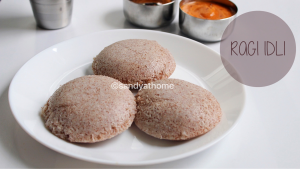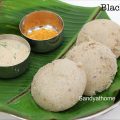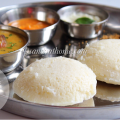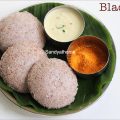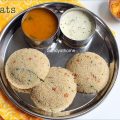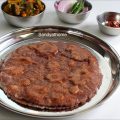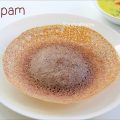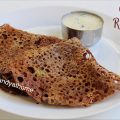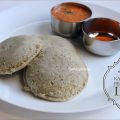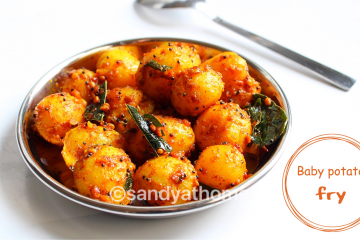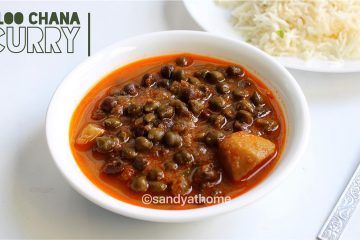Ragi idli/ Finger millet idli is a soft, spongy, fluffy and healthy Steamed Indian cake prepared with fermented ragi flour (known as Nachni or Finger millet flour), idli rice, poha, and urad dal batter.
About Ragi Idli:
Ragi idli is brown in color due to the addition of ragi flour but is very nutritious and healthy idli. These ragi idli’s are extremely soft, fluffy and tasty just like regular idli and gives a healthy start to your day. These ragi idli’s goes well with any spicy chutney, idli chutney powder or sambar.
Ragi/ Finger millet batter:
Ragi idli can be made from scratch by adding it to the freshly ground batter before fermentation or adding ragi flour to regular idli batter as well which is more instant. But I made this batter in first method by adding ragi flour to freshly ground batter as I like it that way and also yields in soft and fluffy idli’s. This fermented ragi batter recipe is prepared with ragi flour, Idli rice, urad dal and poha making it a multi purpose batter with which we can make crispy Ragi dosa, Ragi Idli, Ragi paniyaram and Ragi uttapam.
Health benefits of Ragi / Finger millet:
- Ragi/ Finger millet is a whole grain that is gluten-free.
- It naturally contains iron which is a boon for people with low hemoglobin levels or anemic.
- It is also a rich source of fiber keeping the stomach full for a longer time and prevents unwanted cravings leading to weight loss.
- It is one of the best non-dairy sources of calcium necessary for healthy bones and teeth.
- Finger millet/ Ragi is a great body coolant.
- The low glycemic index lessens food cravings and maintains the digestive pace, consequently keeping blood sugar within the safe range.
- Regular consumption of Ragi is highly beneficial in dealing with conditions of anxiety, depression and insomnia.
- Ragi is also one of the very few natural sources of vitamin D, which helps to revert skin aging.
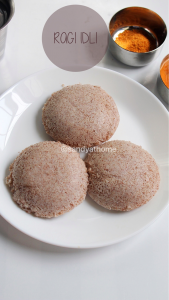 Expert Tips:
Expert Tips:
Soak Idli rice, separately and Urad dal and poha together or all soaked all together for at least 5 to 6 hours.
After 5 to 6 hours grind urad dal and poha first, when the mixture becomes a little coarse say after 2 to 3 minutes of grinding gradually add soaked Idli rice to grind or grind everything together to save some time. The grinding time for the mentioned quantity should be approx. 20 to 30 minutes.
Grind the batter to pouring consistency as we will add ragi flour to it which will yield thick Idli batter consistency.
Allow the batter to ferment for 4 to 6 hours depending on the climate. Fermentation takes place it warm place so place the batter in an oven with pilot light on or cover it with blanket with heater on.
Ragi batter usually ferments within 4 hours during summer and within 5 hours during cold season. So keep checking the batter after 3 hours as it tastes really sour making it unpleasant taste for idli’s, but you could still make crispy dosa.
How to find if batter is fermented?
A well well fermented batter will be light and fluffy in texture, risen its quantity, bubbly with a mild sour aroma.
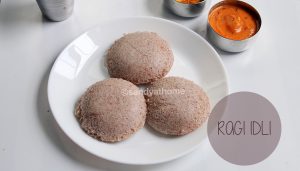

- 1. Idli rice –1 ½ cups
- 2. Whole urad dal- ½ cup
- 3. Ragi flour/ Finger millet flour – 1 cup
- 4. Poha – 2 tbsp
- 5. Salt - to taste
- * 1 cup = 235 ml
- In a bowl add idli rice, white whole urad dal and poha together. Wash 3 to 4 times until you see clear water. Soak it in enough water for 5 to 6 hours. ( I soaked it in 2 cups of water)
- After 6 hours, in a wet grinder add little quantity of the soaked idli rice, urad dal and poha. Switch on the grinder, when it starts grinding gradually add little by little of all the soaked items. Grind the mixture into a smooth, thick and fluffy batter with adding water in regular intervals when needed. I used 2 cups of water for grinding but it may vary according the soaking time. But the measurement is just a guideline to get a perfect batter. I made the batter little watery as we will add ragi flour later and the consistency of the batter will be perfect. Also scrap the inner sides of the grinder often to get rid of coarse urad dal and rice mixture using the scrapper provided along with grinder.
- When done grinding transfer the mixture to a bowl, add salt and ragi flour. Mix the batter well. If the batter is too thick add water gradually to form perfect batter consistency. Now allow it to ferment for 8 to 10 hours. (If you are in cold country leave the batter in microwave undisturbed or keep it in the oven with just the light on so that it creates warm atmosphere fir the batter to ferment. Also suggested time is soak rice and urad dal in the morning, grind it in the evening and let it ferment overnight)
- When the batter has fermented it can be used to make dosa and idli. Next day morning you can see the batter have little rise. Mix it well and keep it aside.
- Now heat water in idli pot. Grease idli plates with few drops of oil. Pour ladle of batter in each idli mold and place the batter filled idli plates in the idli steamer and steam it for 10 to 12 minutes.
- When done remove the idli plate from the steamer and keep it aside for 2 minutes. After 1 - 2 minutes wet a spoon with little water and scoop idli from the idli plate and serve it hot with chutney of your choice!
How to make ragi idli with step by step images
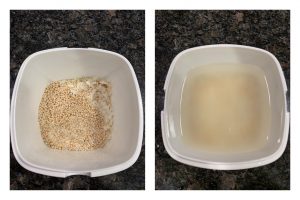
- In a bowl add idli rice, white whole urad dal and poha together. Wash 3 to 4 times until you see clear water. Soak it in enough water for 5 to 6 hours. ( I soaked it in 2 to 3 cups of water)
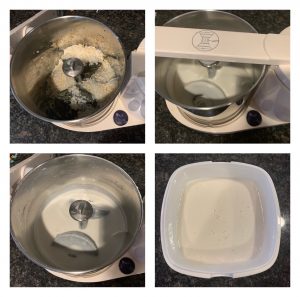
- After 6 hours, in a wet grinder add little quantity of the soaked idli rice, urad dal and poha. Switch on the grinder, when it starts grinding gradually add little by little of all the soaked items. Grind the mixture into a smooth, thick and fluffy batter adding water in regular intervals when needed. I used 2 cups of water for grinding but it may vary according the soaking time. The measurement is just a guideline to get a perfect batter. I made the batter little watery as we will add ragi flour later and the consistency of the batter will be perfect. You can make regular batter, add ragi flour and then add water to adjust the consistency, either way it will work. Also scrap the inner sides of the grinder often to get rid of coarse urad dal and rice mixture using the scrapper provided along with grinder. When done grinding transfer the mixture to a bowl.
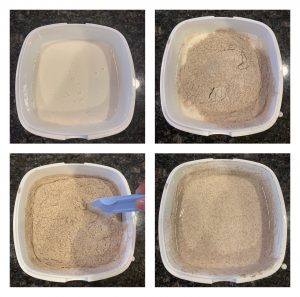
- Now to the ground batter add salt and ragi flour. Mix the batter well. If the batter is too thick add water gradually to form perfect batter consistency.
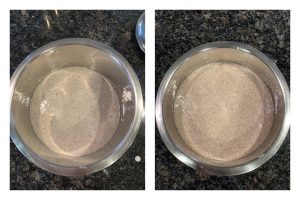
- Now allow the batter to ferment for 8 to 10 hours. (If you are in cold country leave the batter in microwave undisturbed or keep it in the oven with just the light on so that it creates warm atmosphere for the batter to ferment. Also suggested time is to soak rice and urad dal in the morning, grind it in the evening and let it ferment overnight, but this time i soaked at night and ground the batter in the morning which made the fermentation even better) When the batter has fermented it can be used to make dosa and idli. Next day morning you can see the batter have little rise.
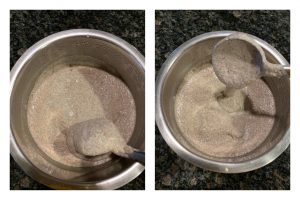
- In the morning mix the batter well and keep it aside. Heat water in idli pot.
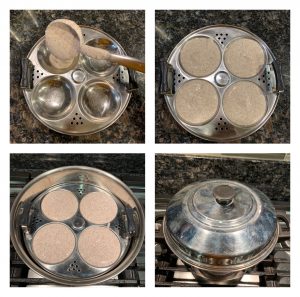
- Grease idli plates with few drops of oil. Pour ladle of batter in each idli mold and place the batter filled idli plates in the idli steamer and steam it for 10 minutes.
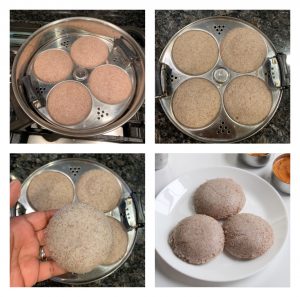
- When done remove the idli plate from the steamer and keep it aside for 2 minutes. After 1 – 2 minutes wet a spoon with little water (wetting the spoon with water helps in and scoop idli from the idli plate) scoop idli from the idli plate and serve it hot with chutney of your choice!
